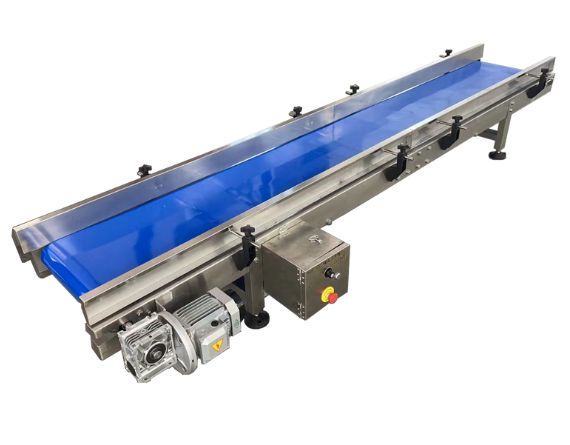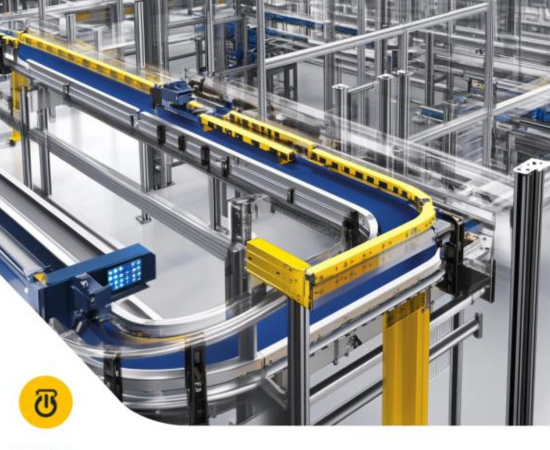Streamline Your Workflow with Precision: Flat Belt Conveyors for Every Industry.
What Is A Flat Belt Conveyor?
A flat belt conveyor is a continuous loop of flexible material—typically PVC, PU, or rubber—stretched between two or more pulleys to transport products along a predefined path. The drive pulley, powered by an electric motor , propels the conveyor belt, while idler rollers and a take-up unit maintain tension and alignment. Flat belt conveyors are the most common conveyor belt system, prized for their simplicity, smooth surface, and ability to handle everything from lightweight packages to heavy bulk materials. They serve as the backbone of many material handling and food industry conveyor belt applications, offering a reliable, cost-effective solution for straight-line transport, gradual inclines or declines, and integration with other equipment such as weighers, fillers, and packagers.
Technical Specifications
| Parameter | Specification |
|---|---|
| Belt Material | PVC/Rubber/PU |
| Frame Material | Stainless Steel/Aluminum |
| Belt Width | Customizable |
| Belt Speed | Variable |
| Load Capacity | Up to 1000 kg |
| Power Supply | 220V/380V |
| Temperature Range | -10°C to 60°C |
| Compliance | CE/ISO Standards |
Key Advantages
-
Versatility: Suitable for transporting a wide range of products, including small parts, packages, and bulk materials.
-
Cost-Effective: Simple design leads to lower initial investment and maintenance costs.
-
Quiet Operation: Low noise levels make it ideal for environments where noise reduction is important.
-
Ease of Installation: Straightforward assembly and integration into existing systems.
-
Customizable: Available in various lengths, widths, and materials to suit specific application needs.


Structural Components of Flat Belt Conveyors
-
Conveyor Belt: The belt itself is typically made from durable materials like rubber, PVC, or fabric. It serves as the surface on which materials are transported.
-
Drive Pulley: This pulley is connected to a motor and provides the necessary force to move the belt. Its surface is often roughened or lagged to increase friction and prevent slippage.
-
Idler Pulley: Located at the opposite end of the conveyor, the idler pulley helps maintain belt tension and alignment.
-
Idler Rollers: These are positioned along the length of the conveyor to support the belt and the load, ensuring smooth movement and reducing belt sagging.
-
Conveyor Frame: The frame provides structural support to the entire system. It is commonly constructed from materials like stainless steel, aluminum, or galvanized steel, chosen based on the application environment
-
Motor and Drive System: The motor powers the drive pulley, and the drive system may include components like gearboxes to control speed and torque.
-
Take-Up Unit: This component maintains proper belt tension, compensating for belt stretch and ensuring optimal performance.
-
Belt Cleaners and Scrapers: Installed to remove any residual material sticking to the belt, these components help in maintaining cleanliness and preventing material buildup.
-
Safety and Control Devices: Features like emergency stop switches, sensors, and guards are integrated to ensure safe operation and to monitor system performance.
Flat Belt Conveyor Application
-
Manufacturing: Assembly lines, packaging, and material handling.
-
Food Processing: Transporting products through various stages of production.
-
Warehousing: Moving goods within storage facilities.
-
Logistics: Sorting and distributing packages in distribution centers.
-
Retail: Conveying products in supermarkets and retail stores.


Types of Flat Belt Conveyors
-
Slider Bed Conveyors: Feature a flat surface (bed) over which the belt slides. Ideal for light to medium-duty applications.
-
Roller Bed Conveyors: Utilize rollers to support the belt, reducing friction and suitable for heavier loads.
-
Inclined/Declined Conveyors: Designed to move products between different elevations.
-
Sanitary Conveyors: Constructed with materials and designs that meet hygiene standards, perfect for food and pharmaceutical industries.
-
Portable Conveyors: Lightweight and mobile, these conveyors can be easily moved and adjusted as needed.
The Flat Belt Conveyors from Fill Package are versatile, efficient, and reliable solutions for various industries. Their advanced features and customizable options make them an excellent choice for enhancing productivity and operational efficiency.
Select belt width and conveyor length based on your product dimensions, throughput requirements, and available floor space. A wider belt accommodates larger or multiple items; a longer conveyor meets higher capacity needs. We’ll help you calculate the optimal conveyor belt size for your process.
Our belts are available in food-grade PVC, PU, or rubber covers, selected for durability and hygiene. The frame is typically stainless steel for corrosion resistance, making it ideal for wet or wash-down environments.
Maintenance is simple:
-
Belt alignment checked monthly
-
Tension adjusted via the take-up unit
-
Cleaners/scrapers keep the belt surface clear
Spare parts (rollers, pulleys) are readily available, minimizing downtime.
Yes. For slopes up to 15°, we offer inclined flat belt conveyors with high-friction belts or cleats. Decline models use controlled braking or stepped profiles to prevent product over-run.
- Food-grade belts withstand daily wash-down.
- Modular decks or removable sections speed up cleaning.
- Belt scrapers remove residue continuously.
This makes flat belt conveyors suitable for stringent hygiene standards.
- Standard flat belt systems: 15–20 days production
-
Customized designs: 20–30 days
Cost depends on length, width, belt material, and any special features. We’ll provide a detailed cost of belt conveyor estimate tailored to your requirements.
Absolutely. Our conveyors support seamless connection to weighers, fillers, packers, and other equipment. We supply dimensional drawings and coordinate installation to ensure perfect integration.
Depending on belt type and frame design, flat belt conveyors can transport loads from a few grams (fragile items) up to several hundred kilograms per meter. We’ll specify the right belt thickness and roller spacing for your product weight.
Very. You can choose:
-
Belt material & surface finish
-
Frame length, width & height
-
Incline/decline angles
-
Washdown or hygienic options
-
Side guards, guides & sensors
This ensures the conveyor fits your exact application.

